Chapter
Five Part Two
|
During February of
1925, but much nearer home, Henry Seagrave and Parry Thomas
were at Montlhery with a six cylinder supercharged 2 litre
car, with the view of a spot of record breaking. They made
attempts on the 12 and 24 hour world records in which they
were unsuccessful, but they did take a number of records
including the 3 hours at l02.74m.p.h. but engine trouble and
a snow storm put paid to the longer distance records.
Various other
records fell during the year to both Seagrave and Campbell.
The first big race of the year for Sunbeam came on June 20th
when the Wolverhampton cars made their debut at Le Mans for
the 24 hour race. Louis Coatalen had decided to enter two
cars for the 1925 Les Vingt Quatre Du Mans and prototypes of
a new super sports model were prepared for this testing
race. It was first held in 1923 and happily is still an
annual event. |
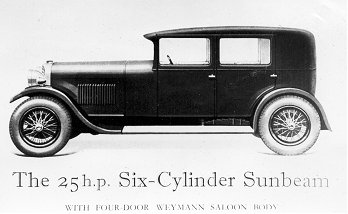 |
The cars had six cylinders and double
overhead camshaft engines with cylinder dimensions of 75 x
110mm. The 3 litre engines could be taken up to 5,000r.p.m.
and developed l46b.h.p. They had a four speed gearbox and
weighed 26cwt. One of the prototypes had been tested by
“Autocar” and they reported it to be able to exceed
90m.p.h., have excellent road holding and to be very
comfortable to drive. Something that was unexpected in a
high performance sports car. |
| Sunbeam’s drivers for Le Mans were
Henry Seagrave and George Duller, a well known steeplechase
jockey, and Jean Chassagne and Sammy Davies of the
“Autocar”. Two Bentleys also represented Britain and the
race included a host of French and Italian cars. For the
first time the famous Le Mans start was used and right from
the word go the Sunbeams took the lead. For the first 200
miles cars had to run with the hood erected, which
handicapped them somewhat, but did prove that they carried
useable touring equipment. A great battle developed between
Seagrave and Kensington Moir driving a Bentley with the
Wolverhampton car having a slight edge over its rival. It
held the lead for 11 laps until carburettor trouble delayed
Seagrave. The Bentley also struck trouble, but of a more
serious sort, running out of petrol some miles from the
permitted refuelling stop and so had to retire. The other
Bentley of J.F. Duff and Frank Clement was also having
problems and the half distance positions were two Lorraine
Dietriches leading with the Chassagne/Davies' Sunbeam 3rd.
The other Sunbeam car had fallen out with clutch trouble.
These positions were held for the next
couple of hours but then the Sunbeam speeded up and moved
into second place to increase its speed yet again to begin
to catch the leader. Unfortunately it couldn’t quite manage
it and the Lorraine Deitrich driven by de
Courcelles/Rossignol won, having covered l,388 miles at an
average speed of 57.83m.p.h. The Chassagne/Davies Sunbeam
had covered about 45miles less at 55.9m.p.h. and another
Lorraine Deitrich finished third. Of the 49 starters only 20
finished, the Sunbeam being the only British car amongst
them. The Seagrave/Duller team received an award for
covering the greatest distance in the first hour and the
winning car received a 500 franc prize for the most
comfortable body. |
|
Sunbeam were not
very successful in the other continental races of that year.
Three of the six cylinder supercharged 2litre G.P. cars were
entered for the French Grand Prix at Montlhery to be driven
by Seagrave, Count Masetti and Count Conelli. The race, over
a distance of 620 miles was won by Robert Benoist driving a
Delage with team mate Louis Wagner 2nd. Masetti brought his
Sunbeam in 3rd but both Seagrave and Conelli had retired
with mechanical trouble in the early stages of the race,
which had been marred by the fatal crash of Antonio Ascari
of the Alfa Romeo team, who then withdrew from the race.
Only one Sunbeam was
entered for the Spanish Grand Prix, again held at San
Sebastian. The car was driven by Masetti, who when going
very well in 2nd place in the 450 mile race, had to retire
at half distance. |
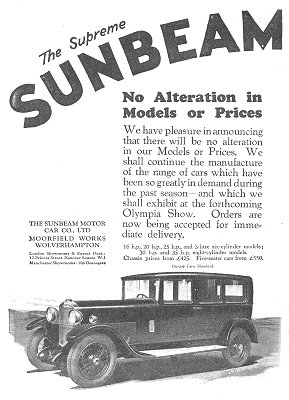 |
|
As usual, the
following season’s models were exhibited at the motor show.
The 1926 Sunbeam range consisted of the previous season’s
14/40, now reduced by £60 to £625, and the 20/60 which
remained at £950. The 12/30 had been dropped and several new
models were introduced. Sunbeam were keen to market their
super sports 3 litre car which had a six cylinder 75 x 110mm
engine with double overhead camshafts and two Claudel
carburettors. This very fine car sold for £1,125. Also new
for 1926 was the 30/90 with the straight eight engine, which
could be had in two versions. The first had cylinder
dimensions of 80 x 120mm and a capacity of 4825c.c. The
second was slightly larger at 85 x 120mm with a capacity of
5028c.c. The former was listed at a chassis price of £1,050
and the later at £1,250. If ordered with standard or
limousine bodywork the price to £1,850. The finish would be
in claret, or dark blue. These were very fine motors, but
rather expensive.
The company
continued to be in financial difficulties as indeed were the
whole of the STD group and early in 1926 it was made known
that no new racing cars would be built as Sunbeams, only the
French Talbot Darracq taking part in international racing.
No dividend had been paid on the £1 ordinary shares for a
number of years and payments on the £1 Preferred ordinary
shares were in arrears since1923. Profits over the three
years since 1923 had been a little over £396,000 and there
were many calls on the cash and the situation was decidedly
gloomy.
Star were continuing
to build excellent cars at Frederick Street and the body
works at Bushbury were in full swing. |
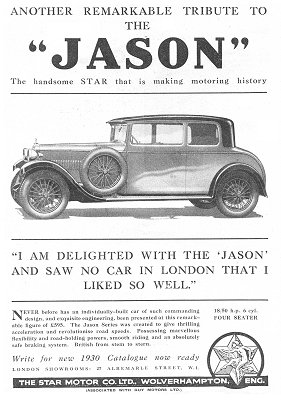 |
At this time some
craftsmen were brought in from the Surrey works of Weyman to
oversee the building of fabric bodies. New models introduced
at this time were the o.h.v. 14/40 and 20/60, all with four
wheel brakes. Towards the end of the year a number of 14/40s
were supplied to the Royal Army Service Corps.
The motor industry
has always had its ups and downs and Star was no exception.
At one period during 1926 they were very slack and men were
laid off, some of them for as long as six months. Then of
course there was the General Strike in May which caused a
lot of difficulties. Star closed both the Frederick Street
and Bushbury works and other major Wolverhampton motor firms
had similar problems. Sunbeam were at a standstill with
about 2,500 men out, but at Guys about 500 were out and
something like 200 employees were at work, so some
production continued. A.J.S. carried on with only about 60
out at their Graiseley works. |
|
Leaving aside the
strife, which did great damage to industry, we will look at
what Guy Motors were doing. As already mentioned they were
innovators and introduced many new ideas. One such was their
move into bus manufacture in 1926 when they produced the
first six wheeled trolley bus for Wolverhampton Corporation
Transport. It also included several other advanced features
such as regenerative braking. When the driver took his foot
off the power pedal, power was fed back into the overhead
wires and slowed the vehicle down to about 12m.p.h. without
touching the brake. This system would be widely used but was
not taken up by other manufacturers for something like seven
years.
Just prior to the
introduction of this advanced vehicle Guy had supplied
Wolverhampton with a six wheel double decker motor bus,
again years ahead of their competitors. The specification
included a four cylinder 5 litre engine, which developed
38b.h.p. at 1,000r.p.m., a four speed gearbox and a normal
control layout. Over the next few years large numbers were
sold.
There were also new
models in the motorcycle world. A.J.S. introduced their
first overhead valve 500c.c. with cylinder dimensions of 74
x 93mm. It was in effect an enlarged 350c.c., which followed
the T.T. design. It included duralumin rockers, double row
roller bearings for the big end, and cylinder head fixing by
two long bolts instead of a steel strap. This fine sporting
machine cost £62.10s.0d. (£62.50.).
Diamond now offered
three models. The first was a 147c.c. Villiers powered two
stroke with Albion 2 speed gearbox and chain come belt
drive. The second included a Villiers 172c.c. engine, a 3
speed Sturmey gearbox and all chain drive. The third model
had a 300c.c. JAP engine, a Sturmey 3 speed gearbox and all
chain drive.
Sunbeam offered a
range of six excellent machines. The Model 1, a 347c.c. side
valve machine with Sunbeam 3 speed gearbox and all enclosed
chain drive was listed at £72. The famous overhead valve
Model 9 sold at £91.7s.0d. (£91.35.). Sidecars ranged in
price from £18 to £28.7s.0d. (£28.35). All models had
quickly detachable wheels and 3" tyres were optional.
|
|
Moving on to the
racing scene of 1926 we note that one of the first races of
the year was held in South Africa on January 1st and 2nd.
You can’t get earlier than that! The races were held over
ten laps of a twenty mile circuit, including five miles of
the main Port Elizabeth road, which was not closed to normal
traffic for either practice runs or the race itself. Both
the 350c.c. and 600c.c. races were won by C.H. Young riding
Royal Enfields. In the smaller class R.F. Brown took 3rd
spot on his A.J.S. whilst other riders of the Wolverhampton
machines came in 4th, 5th and 8th. In the 600c.c. race 2nd
and 3rd places went to A.J.S. riders P. Lievardt and J.W. Du
Toit.
There would be
numerous other victories for A.J.S. but we shall now move to
June and the Isle of Man again. Wolverhampton was well
represented in the 1926 Junior T.T. race. There were 7
A.J.S. machines, 4 Sunbeams and 3 HRDs. The Senior included
8 HRDs, 6 AJs and 3 Sunbeams. |
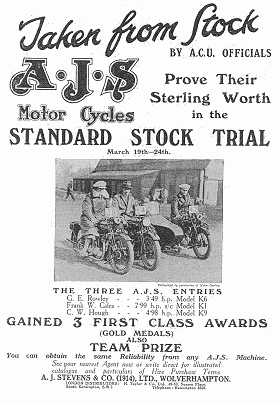 |
| Diamond were also back on the Island
with a single entry in the Lightweight Race and this we
shall consider first. Conditions
were near perfect on race day and on practice form the
Cottons and their star rider Paddy Johnson were favourite to
win. Many felt however that Italian ace Petrio Ghersi could
well pull it off. He had been very fast indeed in practice
and right from the off it was the Italian who shot into the
lead breaking the lap record from a standing start, putting
it to 62.12m.p.h. Ghersi led for the first four laps but was
then delayed and Johnson went into first place, soon to have
an advantage of 39 seconds. Things soon changed when Ghersi
regained the lead after an almost super human effort. The
Cotton rider now really dug the spurs in and went through to
win by 20 seconds from the Italian, with Cottons in the next
two places. This was followed by a sensational ruling.
Ghersi was disqualified on a technicality, he had used a
sparking plug of a different make from that stated on his
entry form. This gave the Gloucester made Cottons the first
three places. Johnson had averaged 60.20m.p.h., a
lightweight record. F.G. Morgan finished 2nd, about 23
minutes behind the winner with W. Colgan 3rd. Fastest lap
fell to Ghersi who went round in 35minutes 49seconds, a
record speed of 63.12m.p.h.
But what of the
single Diamond. When rider Syd Gleeve collected his machine
just prior to the start he discovered it had a flat tyre. He
duly repaired it, but this meant a late start and he went
off in 21st place instead of his allotted 6th spot. Gleeve
rode a steady race from then on and came onto the leader
board in 11th place on lap 4. Next time round he moved up
one place and held this position for some time, eventually
moving up several places to finish in 7th place. This was
Diamond’s best ever T.T. result. Incidentally Syd Gleeve's
fastest lap time was 44 minutes 32 seconds. Diamond were
only a small company but they had the courage to compete
with the worlds best and it is a great pity that their T.T.
efforts did not enjoy more success.
|
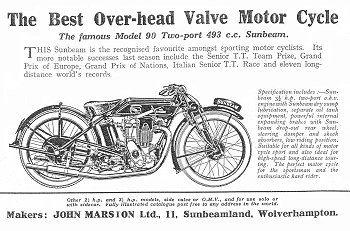 |
There were 14 Wolverhampton made
motorcycles entered for the Junior race with such
outstanding riders as Simpson, Longman, Dance, Hough, the
Twemlow brothers and the up and coming Dodson. Great things
were expected of them but there would be plenty of
opposition from amongst others including Wal Handley on a
very fast Rex Acme, Alec Bennett on a new overhead camshaft
Velocette, and the irrepressible Freddie Dixon riding a
Douglas. |
|
The race got off in
good conditions and at the end of lap one Handley led
Simpson by 22 seconds with Bennett 14 seconds behind
and Dixon in fourth place. By the end of the third lap
Simpson led Handley by four seconds, but Bennett had been
driving the Velo with a whip, lapping in under 34minutes. He
took the lead at the end of lap four with an advantage of 2
minutes 32 seconds over Handley. Simpson was in 3rd spot and
George Dance was going well on his Sunbeam in 6th place.
Clarrie Wise on an A.J.S. and Eddie Twemlow on an HRD
retired.
Bennett kept up the
pace and on lap 5 went round in 32minutes 56 seconds, an
average speed of 68.75m.p.h., a Junior record. It proved to
be the day’s fastest lap and put the Velocette no less than
7 minutes 56 seconds ahead of Jimmy Simpson's A.J.S. in 2nd
place. Wal Handley on his Rex Acme was 18 seconds behind in
3rd place.
Alec Bennett could
now ease off and cruise home, and did so to win the 1926
Junior T.T. in the record time of 3hours 57minutes
37seconds, an average speed of 66.7m.p.h. He also set the
fastest and record lap, and became the first man to
win three T.T. races. 2nd place fell to Jimmy Simpson who
was 10 minutes 25seconds behind the winner. Wal Handley
brought the Rex in 3rd and Freddie Dixon finished 4th.
Of the Wolverhampton
machine placings Charlie Hough finished 8th, Frank Longman
9th, C. Bell 18th and J.H. Stevens 19th on his A.J.S. Jock
Porter took 25th place on the only Sunbeam to finish and
Kenneth Twemlow brought his HRD home in 11th place. Among
notable retirements had been King of the Sprinters George
Dance and Charlie Dodson on Sunbeams and George Rowley on
his A.J.S.
After that excellent
Junior everyone looked forward to a cracking Senior with a
needle match between Stanley Woods making his first T.T.
appearance for the Norton team and Wal Handley on a very
swift ‘V’ twin Rex Acme. Right from the start Jimmy Simpson
dug his spurs in and took his AJ into the lead, covering the
first lap in 32 minutes 27 seconds, an average speed of
69.68m.p.h. This was the fastest Island lap to date and that
from a standing start, giving the AJ rider a lead of
37seconds over Stanley Woods with Handley in third place.
Petrio Ghersi had his Guzzi in fourth place just ahead of
Charlie Hough's A.J.S. and Tommy Spann’s Sunbeam, with Frank
Longman close behind on his A.J.S.
On the 2nd lap
Simpson maintained his cracking pace to complete the lap in
32 minutes 9 seconds, a speed of 70.42m.p.h. This was the
first time the Island had been lapped at over the 70m.p.h.
mark, a fantastic performance that put the Wolverhampton
machine 2 minutes ahead of Wood’s Norton. Handley's Rex was
giving trouble and Ghersi retired. Hough and Longman came up
into 3rd and 4th places, followed by Spann and Howard Davies
on his HRD.
Then came bad news,
J.H. Stevens crashed on his A.J.S. at Brandish Corner, which
of course caused worry in the A.J.S. pit where his parents
were watching the race, however news soon came through that
no serious injuries had been incurred.
The meteoric Simpson
retired with engine trouble at Kirkmichael which put Woods
into a 10 second lead over Hough, now Howard Davies who had
been in 3rd place, crashed and came into the pits to retire
with nasty facial injuries. The very exciting Senior T.T.
continued and when the riders started their 5th lap the
positions were as follows. Stanley Woods on a Norton was
leading from Charlie Hough and Frank Longman, both riding an
A.J.S., Wal Handley followed on his Rex Acme and he in turn
was followed by Joe Craig on a Norton, Eddie Twemlow on an
HRD, and George Rowley on an A.J.S. That was the leader
board and there were 9 Wolverhampton machines in the first
dozen. By lap 6 Woods had increased his lead to l minute 25
seconds, over Hough, whilst Longman still held 3rd place.
Handley had really turned the wick up and was the man to
watch. George Rowley had moved up to 7th place and Graham
Walker had brought his Sunbeam onto the leader board.
The last lap of the
Senior brought great excitement. Hough had speeded up and now
lay only 39 seconds behind Woods with Handley just one second
down on Longman. Around the course the talking points were:
Could Hough catch Woods? Could Handley catch Longman? And indeed
could Handley gain the lead? Fate now took a hand, Hough
crashed at Sulby, fortunately without serious injury, but was
out of the race after a fine ride. This put Woods into a safe
lead of over 4 minutes, and interest now focused on the battle
between Handley and Longman. The Rex rider just managed to pull
out that bit extra to take 2nd place. So the 1926 Senior T.T.
ended with a win for Stanley Woods riding a Norton with a time
of 3 hours 54 minutes 39 seconds, an average speed of
67.54m.p.h. Wal Handley’s Rex Acme was something over 4 minutes
down with Frank Longman in 3rd place on his A.J.S.
Other Wolverhampton
machine placings were C.P. Wood on an HRD in 5th place,
George Rowley and his A.J.S. in 6th, followed by Achillie
Varzi on a Sunbeam, and S. Jackson and Kenneth Twemlow
on HRDs. Graham Walker came 16th on his Sunbeam and was
followed by H.F.Harris on an HRD, and Clarrie Wise on an
A.J.S. Ossie Wade came in 21st on an HRD. Of the 22
finishers 10 were riding Wolverhampton made machines. |
 |
 |
 |
Return to
Part 1 |
Return to
the beginning |
Proceed to
Part 3 |
|